Balkinization
an unanticipated consequence of
Jack M. Balkin
Balkinization Symposiums: A Continuing List
E-mail:
Jack Balkin:
jackbalkin at yahoo.com
Bruce Ackerman
bruce.ackerman at yale.edu
Ian Ayres
ian.ayres at yale.edu
Corey Brettschneider
corey_brettschneider at brown.edu
Mary Dudziak
mary.l.dudziak at emory.edu
Joey Fishkin
joey.fishkin at gmail.com
Heather Gerken heather.gerken at yale.edu
Abbe Gluck abbe.gluck at yale.edu
Mark Graber
mgraber at law.umaryland.edu
Stephen Griffin
sgriffin at tulane.edu
Jonathan Hafetz
jonathan.hafetz at shu.edu
Jeremy Kessler
jkessler at law.columbia.edu
Andrew Koppelman
akoppelman at law.northwestern.edu
Marty Lederman
msl46 at law.georgetown.edu
Sanford Levinson
slevinson at law.utexas.edu
David Luban
david.luban at gmail.com
Gerard Magliocca
gmaglioc at iupui.edu
Jason Mazzone
mazzonej at illinois.edu
Linda McClain
lmcclain at bu.edu
John Mikhail
mikhail at law.georgetown.edu
Frank Pasquale
pasquale.frank at gmail.com
Nate Persily
npersily at gmail.com
Michael Stokes Paulsen
michaelstokespaulsen at gmail.com
Deborah Pearlstein
dpearlst at yu.edu
Rick Pildes
rick.pildes at nyu.edu
David Pozen
dpozen at law.columbia.edu
Richard Primus
raprimus at umich.edu
K. Sabeel Rahmansabeel.rahman at brooklaw.edu
Alice Ristroph
alice.ristroph at shu.edu
Neil Siegel
siegel at law.duke.edu
David Super
david.super at law.georgetown.edu
Brian Tamanaha
btamanaha at wulaw.wustl.edu
Nelson Tebbe
nelson.tebbe at brooklaw.edu
Mark Tushnet
mtushnet at law.harvard.edu
Adam Winkler
winkler at ucla.edu
Compendium of posts on Hobby Lobby and related cases
The Anti-Torture Memos: Balkinization Posts on Torture, Interrogation, Detention, War Powers, and OLC
The Anti-Torture Memos (arranged by topic)
Recent Posts
It’s All over but the Shouting: The Increasing Irrelevance of Abortion Politics
Just A Few Blogs
ACS Blog
Alas, a Blog
Althouse
Arts and Letters Daily
Atrios (Eschaton)
Bill of Health
Buzzflash.com
Buzz Machine
Cato at Liberty
Juan Cole (Informed Comment)
Concurring Opinions
The Constitution in 2020
Corrente
Crooked Timber
Daily Howler
Daily Kos
Dana Boyd
Brad DeLong
Digby (Hullabaloo)
Discriminations
Daniel Drezner
Kevin Drum (Mother Jones)
Electrolite
En Banc
Eunomia (Daniel Larison)
Fafblog
Michael Froomkin (Discourse.net)
GovLab (Beth Noveck)
Rick Hasen (Election Law)
History News Network
How Appealing
Ignatz (Sam Heldman)
The Importance of (Ernie Miller)
Infolaw
Instapundit
International Economic Law and Policy Blog
IntLawGrrls
Jacob Levy
Jesus' General
Jurisdynamics
The Kitchen Cabinet
Mark Kleiman
Law Blog Central
Larry Lessig
Lawyers, Guns and Money
Liberal Oasis
Brian Leiter's Law School Reports
The Leiter Reports
Marginal Revolution
Megan McArdle
Memeorandum
Metafilter
Mirror of Justice
The New Republic
Newseum
No More Mister Nice Blog
Brendan Nyhan
Opinio Juris
Orcinus
The Originalism Blog
Pandagon
Passport (Foreign Policy)
Overcoming Bias
Political Animal (Washington Monthly)
Political Theory Daily Review
Political Wire (Taegan Goddard)
The Poor Man
Virginia Postrel
Prawfsblawg
Public Reason
Jonathan Rauch
Raw Story
Redstate
ReligiousLeftLaw.com
Reporters Committee For Freedom of the Press
Reproductive Rights Blog
Rothman's Roadmap to the Right of Publicity
SCOTUS Blog
Seeing the Forest
Clay Shirky
The Shifted Librarian
The Situationist
Larry Solum (Legal Theory)
Andrew Sullivan
Talking Points Memo
Talk Left
Tapped
Tbogg
TechPresident
The Paper Chase (Jurist)
Tom Paine
Tom Tomorrow (This Modern World)
Eve Tushnet
Uggabugga
University of Chicago Law School Faculty Blog
Unqualified Offerings
The Volokh Conspiracy
War and Piece (Laura Rozen)
Wampum
Oliver Willis
Wonkette
Written Description
Matthew Yglesias
Yin
Your Choice of Feeds
1. XML
powered by
2. Atom Feed
3. RSS 2.0
It’s All over but the Shouting: The Increasing Irrelevance of Abortion Politics
Guest Blogger
[For The Conference on The Future of Sexual And Reproductive Rights]
Neal Devins
Twenty-one years after Robert Bork's failed Supreme Court nomination and sixteen years after Pennsylvania v Casey, the rhetoric of abortion politics sounds eerily familiar. On the eve of the Bork confirmation battle (September 14, 1987), pro-choice activists took out full page ads warning that the Supreme Court was poised to overturn “decisions about marriage an family, childbearing and parenting” and that “if the Senate confirms Robert Bork, it will be too late.” Today, the possibility of the Supreme Court overturning Roe is increasingly becoming an important part of the 2008 presidential elections. On August 27, Jeffrey Rosen wrote in The New York Times that “the landmark ruling on abortion appears to hang by one vote.” On September 1, the Obama campaign ran radio ads talking about what would happen if “Roe v Wade is overturned.”
Rhetorical similarities notwithstanding, the abortion battles of today bear no meaningful resemblance to 1987-1992 era battles. Today's abortion battles principally concern laws demanding that women see an ultrasound before terminating a pregnancy. While these laws (part of an effort to focus on the mental health consequences of abortion) are important, there is little reason to think that they will trigger a significant wave of far-ranging abortion regulation. Likewise, the Supreme Court will not reignite the abortion fires. Republican Supreme Court appointees will not cast the critical votes to overturn Roe; Democratic appointees will not seek to restore Roe's stringent trimester test. Put another way: The 2008 elections will do very little to change the face of abortion rights. The Casey undue burden standard will continue to govern judicial review of abortion rights. And since the states are unlikely to enact significant new restrictions on abortion, it is of only limited significance that the judicial appointees of John McCain and Barack Obama are likely to differ in their applications of Casey.
In sharp contrast, the 1987-1992 abortion battles were hugely consequential. The Reagan administration, as then Solicitor General Charles Fried put it, made Roe v Wade the symbol of everything that had gone wrong in constitutional law. When Ronald Reagan nominated Robert Bork to replace Lewis Powell in 1987, the future of Roe seemed to hang in the balance. Powell played a decisive role in shaping the Roe decision; Bork openly opposed Roe as a wholly unjustifiable usurpation of state legislative power. Even after the Senate turned Bork down because his narrow definition of liberty sets him apart from [this nation s] traditions and history, Roe remained in doubt. In 1989, a plurality of Justices declared in Webster v Reproductive Health Services that the rigid Roe framework is unworkable. By signaling right-to-life interests that the Court was poised to overturn Roe, Webster prompted several states to consider legislation nullifying abortion rights. The decision also turned several gubernatorial races into referendums on abortion rights.
By 1992, however, the political preferences of federal and state lawmakers as well as the American people seemed to have coalesced around a limited right to abortion. Post-Webster efforts to enact laws prohibiting abortions failed as did the gubernatorial campaigns of pro-life candidates. More than that, the Senate effectively demanded that Supreme Court nominees embrace some form of privacy rights and otherwise made clear that nominees openly opposed to Roe would not be confirmed. At the same time, Supreme Court rulings overturning informed consent laws, including waiting period requirements, would continue to meet with resistance.
Planned Parenthood v Casey largely settled the abortion issue by embracing this emerging consensus. In particular, Casey's middle ground solution resonated with both lawmakers and the American people. It solidified government and popular support for limited abortion rights and, in turn, has proven a very durable precedent.
Pro-choice and pro-life interests, however, did not heed Justices O Connor, Kennedy, and Souter's call for "the contending sides of a national controversy to end their national division." 1987-1992 battles were hard fought and elected government preferences were very much in flux throughout most of this period. More than that, pro-choice and pro-life interests both rejected Casey's undue burden standard. To a pro-choice advocate, Casey's balance sells out important interests of women, and, to a pro-lifer, it permits moral outrages to continue. For this very reason, pro-choice and pro-life interests continue to push their agendas so that the smoke of past battles is visible even though the fires have long been extinguished.
In remarks that I will make at the Yale Law School Conference on Reproductive Justice After Carhart, I will make the above claims more concrete in the following ways:
*First, I will look at the social and political forces that contributed to the Supreme Court's decision in Casey. In so doing, I will call attention to the fact that Casey returned the abortion issue to the states. At the time of the decision, the Court had good reason to know that states were not interested in outlawing abortion; instead, state lawmakers, reflecting voter preferences, were interested in enacting the very types of abortion regulations that the Supreme Court approved in Casey. In the years following Casey, for example, states largely steered away from the abortion issue. Rather than see Casey as a wedge (facilitating the enactment of restrictions more draconian than those approved by the Court), the focus of state legislative efforts were the enactment of the very laws approved by the Court. In sharp contrast, opposition to the Roe trimester test was widespread. From 1973 (the year Roe was decided) until 1989, 306 anti-abortion measures were passed by 48 states. And while the vast majority of these states enacted abortion restrictions that the Supreme Court had found permissible (funding bans, parental notification/consent), a dozen states regularly challenged the Roe framework. Under this account of Casey, the Court diffused the abortion issue by both embracing a middle-ground standard and applying it in ways that validated elected government preferences. In particular, by approving four of the five provisions of the Pennsylvania Abortion Control Act of 1982, the Pennsylvania statute became a template for states considering abortion regulations (and the Casey Court's approval of those provisions a measuring stick for federal courts considering undue burden challenges to post-Casey enactments).
*Second, I will use Gonzales v Carhart as a vehicle to highlight the stability of abortion politics today. Neither federal nor state lawmakers saw partial birth bans as a wedge to pursue far-ranging regulation of abortion. Correspondingly, abortion politics was not transformed when Samuel Alito joined the Court (and then cast the decisive vote upholding federal partial birth legislation in Gonzales). Although right-to-life interest groups understood that the Alito-for- O Connor swap made the Roberts Court especially likely to uphold abortion regulations, state lawmakers did not pick up the pace of legislative enactments. Before Alito joined the Court, states had begun enacting laws requiring women to see a fetal ultrasound before terminating a pregnancy. Some states have enacted such ultrasound laws since the Alito confirmation but there is no reason to think that the Alito confirmation impacted the pace of ultrasound legislation.
The fact that ultrasound legislation is the focus of state legislative reforms is revealing for another reason. Rather than seek a fundamental change in abortion regulation (by enacting legislation that would either repeal abortion rights or test the boundaries of the Casey undue burden standard), state lawmakers seem quite willing to work within the parameters of existing Supreme Court doctrine. Consider the following: The Supreme Court's 2000 rejection of a Nebraska partial birth statute in Sternberg v Carhart did not prompt a legislative backlash; instead, the focus of post-2000 efforts was to craft a partial birth law that the Supreme Court would approve. Likewise, the 2007 approval of the federal partial birth law in Gonzales v Carhart did little more than prompt states with partial birth statutes to revamp those statutes to conform to the federal statute approved in Gonzales. More revealing, states that have enacted legislation signaling their willingness to repeal abortion rights have conditioned those legislative repeals on the Supreme Court's overruling of Roe v Wade. And since (for reasons that I will soon detail) there is no prospect of the Supreme Court overruling Roe, these trigger laws are symbolically important but practically insignificant.
I have no doubt that the above analysis will not ease the concerns of pro-choice advocates. Pro-life interest groups are seeking to transform the abortion debate by shifting the focus away from the fetus and to maternal health. In Carhart, Justice Kennedy embraced these efforts. Lawmakers, moreover, still introduce legislation that would repeal abortion rights. And two states (South Dakota and Colorado) will soon vote on initiatives that would effectively repeal abortion rights. With that said, I think that Robert Post and Reva Siegel’s prediction that Carhart ”will inflame political controversy” did not materialize. Carhart did not significantly impact the type or number of abortion-related measures actually enacted. No state legislature has enacted a repeal measure and no voter initiative has been approved. Polling data, moreover, suggests that there is little reason to think that this election cycle will change things.
The political fallout from the 1987-1992 era (when state voters and, ultimately, elected officials fought off efforts to repeal abortion rights) continues through today. Public opinion on abortion rights has varied little throughout the post-Casey era. That is why states have either steered clear of the issue or enacted legislation that expresses disapproval of abortion without questioning the constitutionality of abortion rights (partial birth bans and ultrasound requirements). And even if an outlier state passed an anti-abortion initiative, there is no reason to think that other states will follow suit. More than that, there is no prospect of the Supreme Court’s embracing such an outlier initiative and, in so doing, overruling Roe.
One final observation about contemporary abortion politics before turning to the question of why the Supreme Court will adhere to the Casey standard. The fact that abortion politics is relatively stable does not mean that the abortion issue has no political salience. Right-to-life interests are successful in having state lawmakers introduce a host of abortion-related reforms, including proposals that will repeal abortion altogether. At the same time, these laws are not being enacted and absent a fundamental shift in public opinion will not be enacted. That is not to say that pro-choice interests do not play an important role in counterbalancing the efforts of right-to-life interests. It is to say, instead, that the appearance of pitched battles about the possible repeal of abortion rights are largely illusory. There is widespread support for limited abortion rights and that support will continue.
*Third, the Supreme Court will not revisit the Casey undue burden standard. Even if a president used his confirmation power to retool abortion doctrine, those efforts would almost certainly fail. The Senate supports limited abortion rights and would not confirm a Justice who opposes Roe (unless that nominee claimed that stare decisis compels continued recognition of abortion rights). Also, social psychology literature suggests that significant obstacles stand in the way of a Justice casting the fifth vote to overturn Roe. In particular, this literature suggests that there is an aversion to becoming the fifth member of a well defined group unless you are strongly committed to the ideals of that group. In other words, a president seeking a fifth vote to overturn Roe would have to find an individual who is pre-committed to overturning Roe but who has never had occasion to express that opposition in ways that would be detectable to the Senate. A survey of books concerning Reagan and Bush (both father and son) appointments to the Supreme Court suggests that the White House is not looking for such a stealth nominee. Indeed, as Jack Balkin has written on this blog, a Republican president may well have incentives to appoint judicial moderates on the abortion issue—rather than risk the political consequences of appointing anti-Roe justices.
Supreme Court recognition of abortion rights therefore seems secure, especially since there is no reason to think there are now 4 Justices willing to overturn Roe. Just as the Supreme Court chipped away at Miranda without overruling the decision, there is no need to think that a Justice opposed to abortion rights would see the need to overturn Roe. States are not enacting abortion repeal legislation. A lax application of the Casey undue burden standard will result in the Court's approval of nearly any abortion law that a state might pass. And such an approach would not prompt the opprobrium of the Senate or voters. Senate confirmation hearings make clear that the Senate is uninterested in the Court's approval of abortion regulations so long as the Court does not nullify abortion rights. Likewise, most voters support the placing of limits on abortion rights. It therefore seems extremely unlikely that judicial approval of abortion regulations would ever trigger a legislative backlash against the Court.
For very much the same reason, there is no reason to think that a president or Supreme Court Justice strongly committed to abortion rights would want to upend the Casey undue burden standard. Whatever one thinks of Casey's rulings on waiting periods, parental rights, and informed consent requirements, it is unimaginable that a coalition of 5 pro-choice Justices would stand together to overturn these rulings and restore the Roe trimester test. To accomplish such a transformation, pro-choice presidents would need to be strongly committed to the restoration of Roe and would need to have several opportunities to appoint Justices also committed to the restoration of Roe (not to mention the fact that efforts to restore Roe would be resisted by lawmakers and the American people). Instead of such a radical transformation, it is far more likely that pro-choice Justices will apply Casey in ways that protect abortion rights.
For pro-choice advocates, the rub here is that states who want to limit abortion rights have already gotten most of what they want. As noted, states consistent with public opinion favor limited abortion rights. Those limits have largely been approved by federal courts of appeals or the Supreme Court. There is little reason to think that the federal courts will revisit these rulings. States strongly resisted Roe during the 1973-1989 period and there is no reason to think that the Court would want to find out whether states would also resist the overturning of post-1992 decisions approving abortion regulations under Casey. Of course, pro-choice advocates would prefer a Court more committed to abortion rights than today's Court. Likewise, just as the Roberts Court's approval of the federal partial birth ban was symbolically important, it would also be symbolically important for pro-choice appointees to lead the charge against ultrasound regulations and possible as applied challenges to partial birth bans.
So decades worth of sturm und drang about abortion rights now appears to be little more than a fight over legislation that—while undoubtedly important--does not meaningfully alter the abortion landscape. But that is where we are today and I suspect that we will be at exactly the same place after this November's elections and for quite some time afterwards. To repeat what I stated at the start of this post: By rejecting the absolutist visions of pro-choice and right-to-life interests, Casey established a framework by which states could limit abortion rights in ways that matched majoritarian preferences. More than establish a standard, Casey also approved specific state laws (waiting periods, informed consent, parental consent). These specific laws became a template for subsequent state regulation of abortion. Indeed, although states have pursued some other abortion-related initiatives (most notably partial birth abortion), the all-or-nothing stakes that characterized 1987-1992 abortion politics are well behind us. Today, most states steer clear of the abortion wars and those that enact legislation pursue measures that are of comparatively little practical consequence. Consequently, although Democratic and Republican nominees might reach different judgments on the constitutionality of ultrasound requirements and partial birth bans, today's abortion wars are largely about rhetorically powerful symbols. These symbols sustain pro-choice and pro-life forces. But they are no more than a shadow of the profoundly important 1987-1992 battles that culminated in the Casey decision.
Posted
4:05 AM
by Guest Blogger [link]
Books by Balkinization Bloggers

Gerard N. Magliocca, The Actual Art of Governing: Justice Robert H. Jackson's Concurring Opinion in the Steel Seizure Case (Oxford University Press, 2025)

Linda C. McClain and Aziza Ahmed, The Routledge Companion to Gender and COVID-19 (Routledge, 2024)

David Pozen, The Constitution of the War on Drugs (Oxford University Press, 2024)

Jack M. Balkin, Memory and Authority: The Uses of History in Constitutional Interpretation (Yale University Press, 2024)
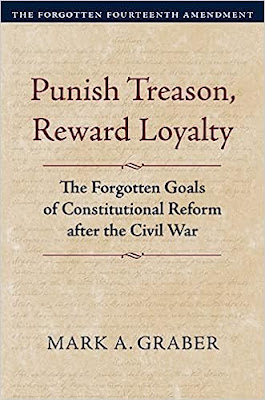
Mark A. Graber, Punish Treason, Reward Loyalty: The Forgotten Goals of Constitutional Reform after the Civil War (University of Kansas Press, 2023)
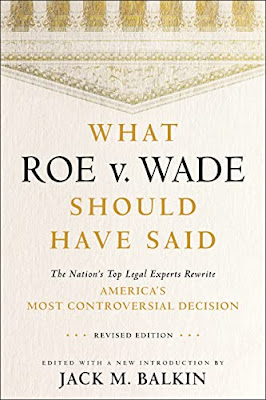
Jack M. Balkin, What Roe v. Wade Should Have Said: The Nation's Top Legal Experts Rewrite America's Most Controversial Decision - Revised Edition (NYU Press, 2023)

Andrew Koppelman, Burning Down the House: How Libertarian Philosophy Was Corrupted by Delusion and Greed (St. Martin’s Press, 2022)

Gerard N. Magliocca, Washington's Heir: The Life of Justice Bushrod Washington (Oxford University Press, 2022)
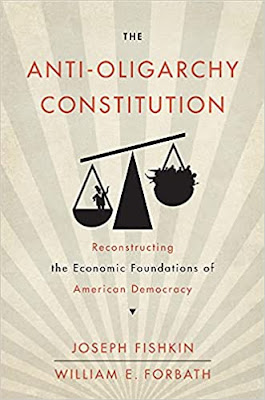
Joseph Fishkin and William E. Forbath, The Anti-Oligarchy Constitution: Reconstructing the Economic Foundations of American Democracy (Harvard University Press, 2022)
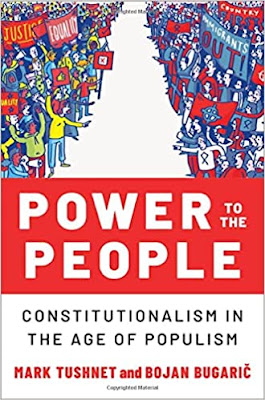
Mark Tushnet and Bojan Bugaric, Power to the People: Constitutionalism in the Age of Populism (Oxford University Press 2021).

Mark Philip Bradley and Mary L. Dudziak, eds., Making the Forever War: Marilyn B. Young on the Culture and Politics of American Militarism Culture and Politics in the Cold War and Beyond (University of Massachusetts Press, 2021).

Jack M. Balkin, What Obergefell v. Hodges Should Have Said: The Nation's Top Legal Experts Rewrite America's Same-Sex Marriage Decision (Yale University Press, 2020)

Frank Pasquale, New Laws of Robotics: Defending Human Expertise in the Age of AI (Belknap Press, 2020)

Jack M. Balkin, The Cycles of Constitutional Time (Oxford University Press, 2020)

Mark Tushnet, Taking Back the Constitution: Activist Judges and the Next Age of American Law (Yale University Press 2020).

Andrew Koppelman, Gay Rights vs. Religious Liberty?: The Unnecessary Conflict (Oxford University Press, 2020)

Ezekiel J Emanuel and Abbe R. Gluck, The Trillion Dollar Revolution: How the Affordable Care Act Transformed Politics, Law, and Health Care in America (PublicAffairs, 2020)

Linda C. McClain, Who's the Bigot?: Learning from Conflicts over Marriage and Civil Rights Law (Oxford University Press, 2020)
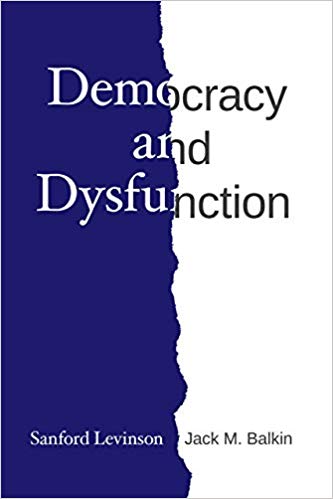
Sanford Levinson and Jack M. Balkin, Democracy and Dysfunction (University of Chicago Press, 2019)

Sanford Levinson, Written in Stone: Public Monuments in Changing Societies (Duke University Press 2018)

Mark A. Graber, Sanford Levinson, and Mark Tushnet, eds., Constitutional Democracy in Crisis? (Oxford University Press 2018)

Gerard Magliocca, The Heart of the Constitution: How the Bill of Rights became the Bill of Rights (Oxford University Press, 2018)

Cynthia Levinson and Sanford Levinson, Fault Lines in the Constitution: The Framers, Their Fights, and the Flaws that Affect Us Today (Peachtree Publishers, 2017)

Brian Z. Tamanaha, A Realistic Theory of Law (Cambridge University Press 2017)

Sanford Levinson, Nullification and Secession in Modern Constitutional Thought (University Press of Kansas 2016)

Sanford Levinson, An Argument Open to All: Reading The Federalist in the 21st Century (Yale University Press 2015)

Stephen M. Griffin, Broken Trust: Dysfunctional Government and Constitutional Reform (University Press of Kansas, 2015)

Frank Pasquale, The Black Box Society: The Secret Algorithms That Control Money and Information (Harvard University Press, 2015)

Bruce Ackerman, We the People, Volume 3: The Civil Rights Revolution (Harvard University Press, 2014)
Balkinization Symposium on We the People, Volume 3: The Civil Rights Revolution

Joseph Fishkin, Bottlenecks: A New Theory of Equal Opportunity (Oxford University Press, 2014)

Mark A. Graber, A New Introduction to American Constitutionalism (Oxford University Press, 2013)

John Mikhail, Elements of Moral Cognition: Rawls' Linguistic Analogy and the Cognitive Science of Moral and Legal Judgment (Cambridge University Press, 2013)

Gerard N. Magliocca, American Founding Son: John Bingham and the Invention of the Fourteenth Amendment (New York University Press, 2013)

Stephen M. Griffin, Long Wars and the Constitution (Harvard University Press, 2013)

Andrew Koppelman, The Tough Luck Constitution and the Assault on Health Care Reform (Oxford University Press, 2013)

James E. Fleming and Linda C. McClain, Ordered Liberty: Rights, Responsibilities, and Virtues (Harvard University Press, 2013)
Balkinization Symposium on Ordered Liberty: Rights, Responsibilities, and Virtues

Andrew Koppelman, Defending American Religious Neutrality (Harvard University Press, 2013)

Brian Z. Tamanaha, Failing Law Schools (University of Chicago Press, 2012)

Sanford Levinson, Framed: America's 51 Constitutions and the Crisis of Governance (Oxford University Press, 2012)

Linda C. McClain and Joanna L. Grossman, Gender Equality: Dimensions of Women's Equal Citizenship (Cambridge University Press, 2012)

Mary Dudziak, War Time: An Idea, Its History, Its Consequences (Oxford University Press, 2012)

Jack M. Balkin, Living Originalism (Harvard University Press, 2011)

Jason Mazzone, Copyfraud and Other Abuses of Intellectual Property Law (Stanford University Press, 2011)

Richard W. Garnett and Andrew Koppelman, First Amendment Stories, (Foundation Press 2011)

Jack M. Balkin, Constitutional Redemption: Political Faith in an Unjust World (Harvard University Press, 2011)

Gerard Magliocca, The Tragedy of William Jennings Bryan: Constitutional Law and the Politics of Backlash (Yale University Press, 2011)

Bernard Harcourt, The Illusion of Free Markets: Punishment and the Myth of Natural Order (Harvard University Press, 2010)

Bruce Ackerman, The Decline and Fall of the American Republic (Harvard University Press, 2010)
Balkinization Symposium on The Decline and Fall of the American Republic

Ian Ayres. Carrots and Sticks: Unlock the Power of Incentives to Get Things Done (Bantam Books, 2010)

Mark Tushnet, Why the Constitution Matters (Yale University Press 2010)
Ian Ayres and Barry Nalebuff: Lifecycle Investing: A New, Safe, and Audacious Way to Improve the Performance of Your Retirement Portfolio (Basic Books, 2010)
.jpg)
Jack M. Balkin, The Laws of Change: I Ching and the Philosophy of Life (2d Edition, Sybil Creek Press 2009)

Brian Z. Tamanaha, Beyond the Formalist-Realist Divide: The Role of Politics in Judging (Princeton University Press 2009)
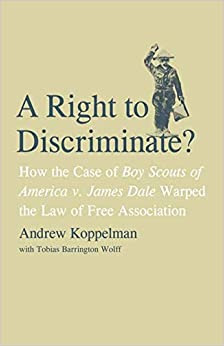
Andrew Koppelman and Tobias Barrington Wolff, A Right to Discriminate?: How the Case of Boy Scouts of America v. James Dale Warped the Law of Free Association (Yale University Press 2009)

Jack M. Balkin and Reva B. Siegel, The Constitution in 2020 (Oxford University Press 2009)
Heather K. Gerken, The Democracy Index: Why Our Election System Is Failing and How to Fix It (Princeton University Press 2009)

Mary Dudziak, Exporting American Dreams: Thurgood Marshall's African Journey (Oxford University Press 2008)

David Luban, Legal Ethics and Human Dignity (Cambridge Univ. Press 2007)

Ian Ayres, Super Crunchers: Why Thinking-By-Numbers is the New Way to be Smart (Bantam 2007)

Jack M. Balkin, James Grimmelmann, Eddan Katz, Nimrod Kozlovski, Shlomit Wagman and Tal Zarsky, eds., Cybercrime: Digital Cops in a Networked Environment (N.Y.U. Press 2007)
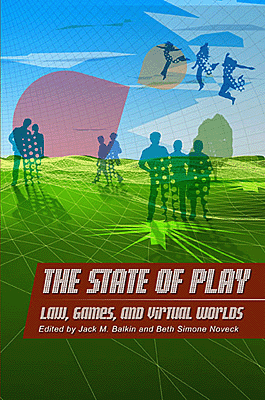
Jack M. Balkin and Beth Simone Noveck, The State of Play: Law, Games, and Virtual Worlds (N.Y.U. Press 2006)

Andrew Koppelman, Same Sex, Different States: When Same-Sex Marriages Cross State Lines (Yale University Press 2006)
Brian Tamanaha, Law as a Means to an End (Cambridge University Press 2006)
Sanford Levinson, Our Undemocratic Constitution (Oxford University Press 2006)
Mark Graber, Dred Scott and the Problem of Constitutional Evil (Cambridge University Press 2006)
Jack M. Balkin, ed., What Roe v. Wade Should Have Said (N.Y.U. Press 2005)
Sanford Levinson, ed., Torture: A Collection (Oxford University Press 2004)
Balkin.com homepage
Bibliography
Conlaw.net
Cultural Software
Writings
Opeds
The Information Society Project
BrownvBoard.com
Useful Links
Syllabi and Exams